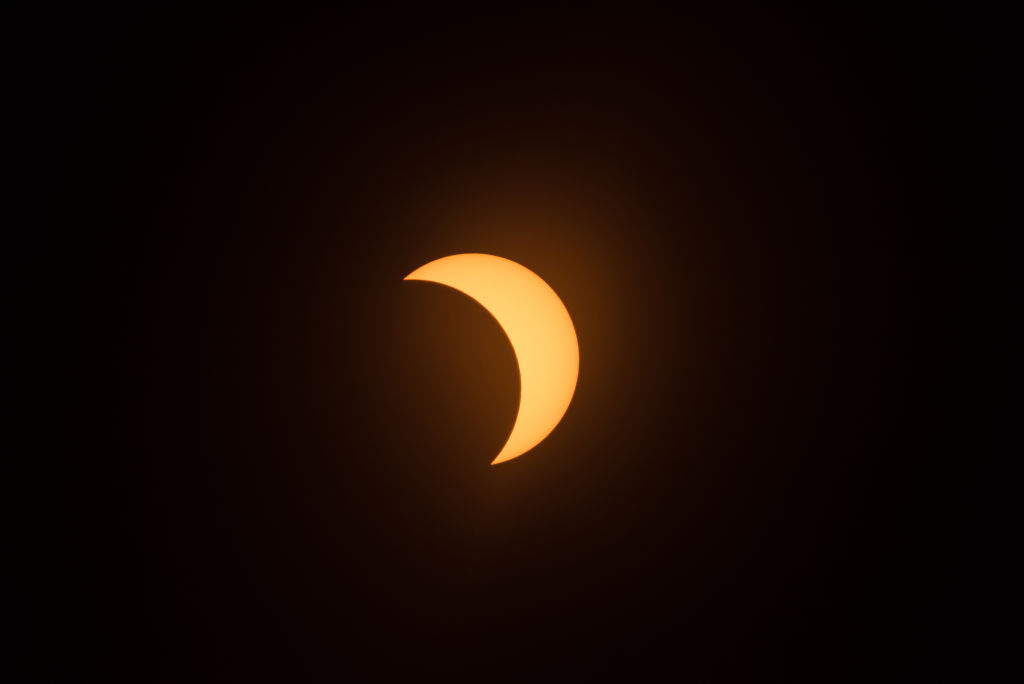
The moon will pass in front of the sun on April 8 to create a total solar eclipse, the first since 2017 to hit the lower 48 U.S. states. While the next such eclipse to cross Canada and the U.S. won’t take place until 2044, TIME has rounded up notable depictions of eclipses in novels, TV shows, and movies to help fill the time until then, courtesy of Lisa Yaszek, a Professor of Science Fiction Studies at Georgia Tech.
Eclipses seem to appear in stories when there’s a dramatic change of events in the plot and in moments of “dangerous and negative change, of chaos and confusion,” Yaszek says. Below are eight examples of eclipses in pop culture.
A Connecticut Yankee in King Arthur's Court by Mark Twain
Yaszek calls Twain the first person who used a solar eclipse correctly in a work of modern science fiction. In the story, a 19th century engineer named Hank Morgan gets knocked out and wakes up in medieval Europe, and uses his knowledge of solar eclipses to gain power over Merlin and everyone else in King Arthur’s court. One description of an eclipse reads, “It grew darker and darker and blacker and blacker, while I struggled with those awkward sixth-century clothes. It got to be pitch dark, at last, and the multitude groaned with horror to feel the cold uncanny night breezes fan through the place and see the stars come out and twinkle in the sky. At last the eclipse was total.”
“Nightfall” by Isaac Asimov
This short story is about a group of scientists who have very emotional reactions to an eclipse. As Yaszek puts it, ”It's a really powerful story about both how scientists can get it wrong, but also how scientists have feelings and how we all have feelings and how moved we are by these massive events around us.” One perception of what will take place after an eclipse, from a psychologist: “'’First the eclipse -- which will start in three quarters of an hour -- then universal Darkness and, maybe, these mysterious Stars -- then madness, and end of the cycle.'”
The Three-Body Problem by Liu Cixin
This book, which was recently adapted for a Netflix series, technically features a syzygy, which happens when the sun, moon and earth are in close to a straight line during a solar or lunar eclipse. In the 2008 novel, eclipses are seen as destructive. Aliens are looking to invade Earth because their planet has become unstable and uninhabitable due to multiple eclipses. As Yaszek describes how this science term is used in the novel, “It reminds us of the awe and the terror of eclipses. We tend to associate eclipses with changes in luck, fortune, and history, and The Three-Body Problem is an amazing dramatization of that.”
The Eclipse: Courtship of the Sun and Moon
In this roughly 10-minute 1907 short film, the director Georges Méliés plays an astronomer lecturing a class of young astronomers about an upcoming eclipse. When the time has come, he peers through a giant telescope to watch an eclipse and sees the moon and the sun both have human faces and are winking at one another and sticking their tongues out, seductively, as the moon makes its way to the sun. When the moon covers the sun, the implication is that they’re having some sort of sexual encounter. According to the Princeton University Art Museum, Méliés is considered a “father of the science fiction genre in film.”
2001: A Space Odyssey
Stanley Kubrick’s 1968 classic begins with an eclipse, the Earth, Moon, and the sun in alignment. The Moon gradually moves towards the bottom of the screen, revealing the full sun in an orange glow. It’s not a view from Earth, but from somewhere else in the solar system. Then the movie segues to “the dawn of man.” To Yaszek, opening the movie with an eclipse represents how they “get used to mark these sorts of changes in history and in moments.”
Pitch Black
David Twohy’s 2000 film is set on a remote planet where a spacecraft has crashed, killing most of the passengers. A prisoner played by Vin Diesel turns out to be really helpful during a solar eclipse because he can see perfectly in full darkness. When an eclipse occurs, and chaos erupts during the moment of darkness, the prisoner leads the effort to get things under control. Amid the darkness, an English antiquities dealer finds his stash of fine wine can be used as lighting fuel.
The Simpsons: “Marge vs. the Monorail” and “Gone Maggie Gone”
In the classic episode “Marge vs. the Monorail,” an eclipse occurs while the solar-paneled monorail is speeding out of control. The monorail stops briefly, and when the eclipse passes and the sun comes out, the monorail goes back to speeding out of control. In “Gone Maggie Gone,” the Simpsons family is looking at an eclipse in Springfield through contraptions made out of shoe boxes and a toilet paper roll. Marge looks at the eclipse without glasses and then has to wear a bandage over them for two weeks. A news anchor jokes "a total eclipse is like a woman breastfeeding in a restaurant, it's free. It's beautiful. But under no circumstances should you look at it."
More Must-Reads from TIME
- Cybersecurity Experts Are Sounding the Alarm on DOGE
- Meet the 2025 Women of the Year
- The Harsh Truth About Disability Inclusion
- Why Do More Young Adults Have Cancer?
- Colman Domingo Leads With Radical Love
- How to Get Better at Doing Things Alone
- Michelle Zauner Stares Down the Darkness
Write to Olivia B. Waxman at olivia.waxman@time.com



